How REG.RU climbed to the top
Long time something we did not write to you, habravchane!
Recently, I don’t want to bore you with statistics or post technical instructions — outside the window of heat and stuffiness, body and soul crave for something fresh and different from the routine of everyday work. Fresh as the mountain air. Unusual, as the banner REG.RU, waving at a height of 5621 m above the ground.
So I decided to tell you how just a couple of weeks ago I decided to go to the mountains for the first time, and not somewhere, but at the highest peak of Europe - Elbrus.

')
We must immediately say that physically it was not easy. “Hard” acclimatization, “mountain” illness (headache, insomnia, weakness, shortness of breath after minimal physical activity), heavy backpacks (they approached Elbrus for three days from the North, the most difficult part). At the same time, I have never had such inner peace, I have never been so relaxed from the bustle of the city, as in these majestic, monumental mountains of amazing beauty.
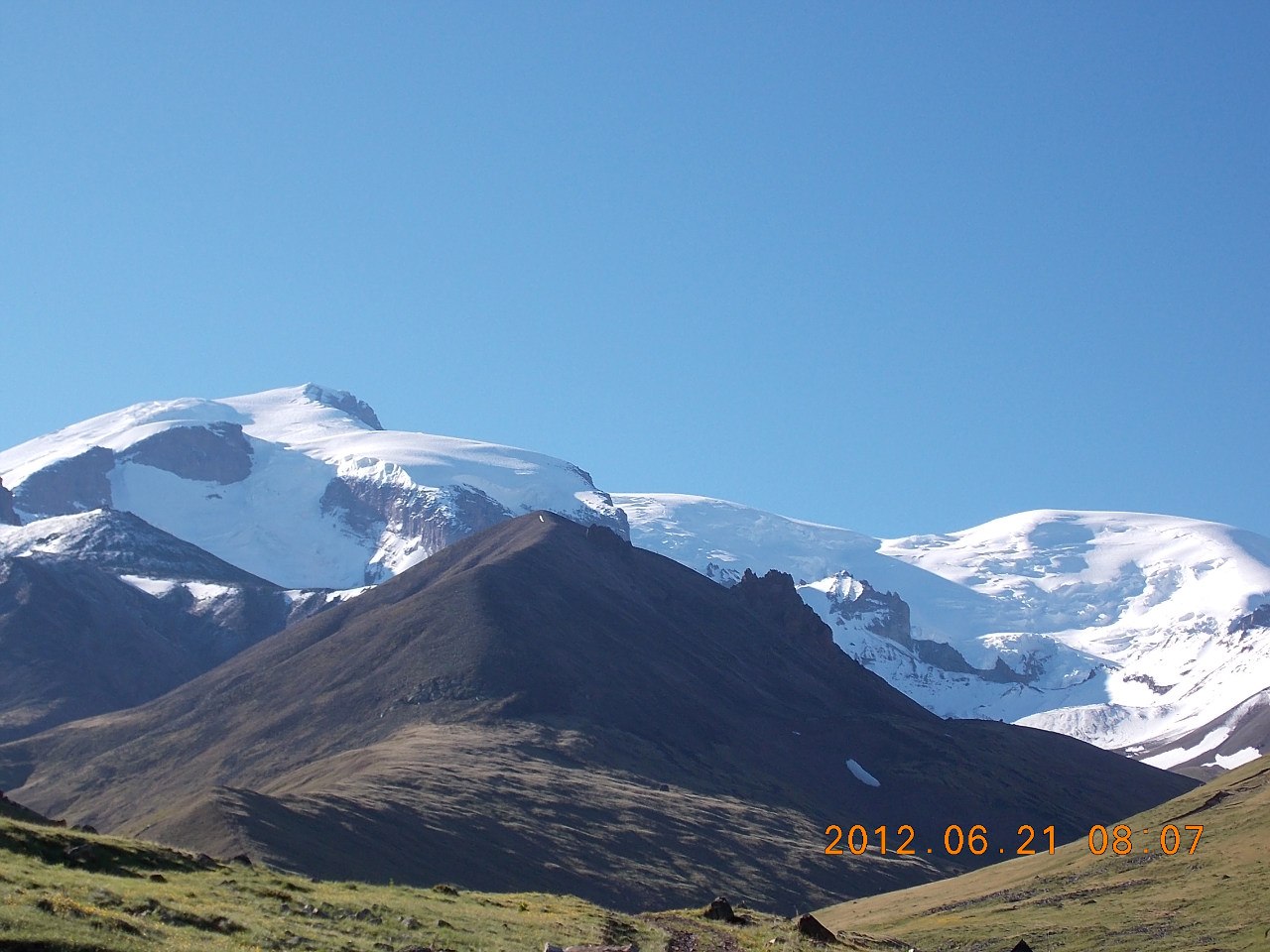
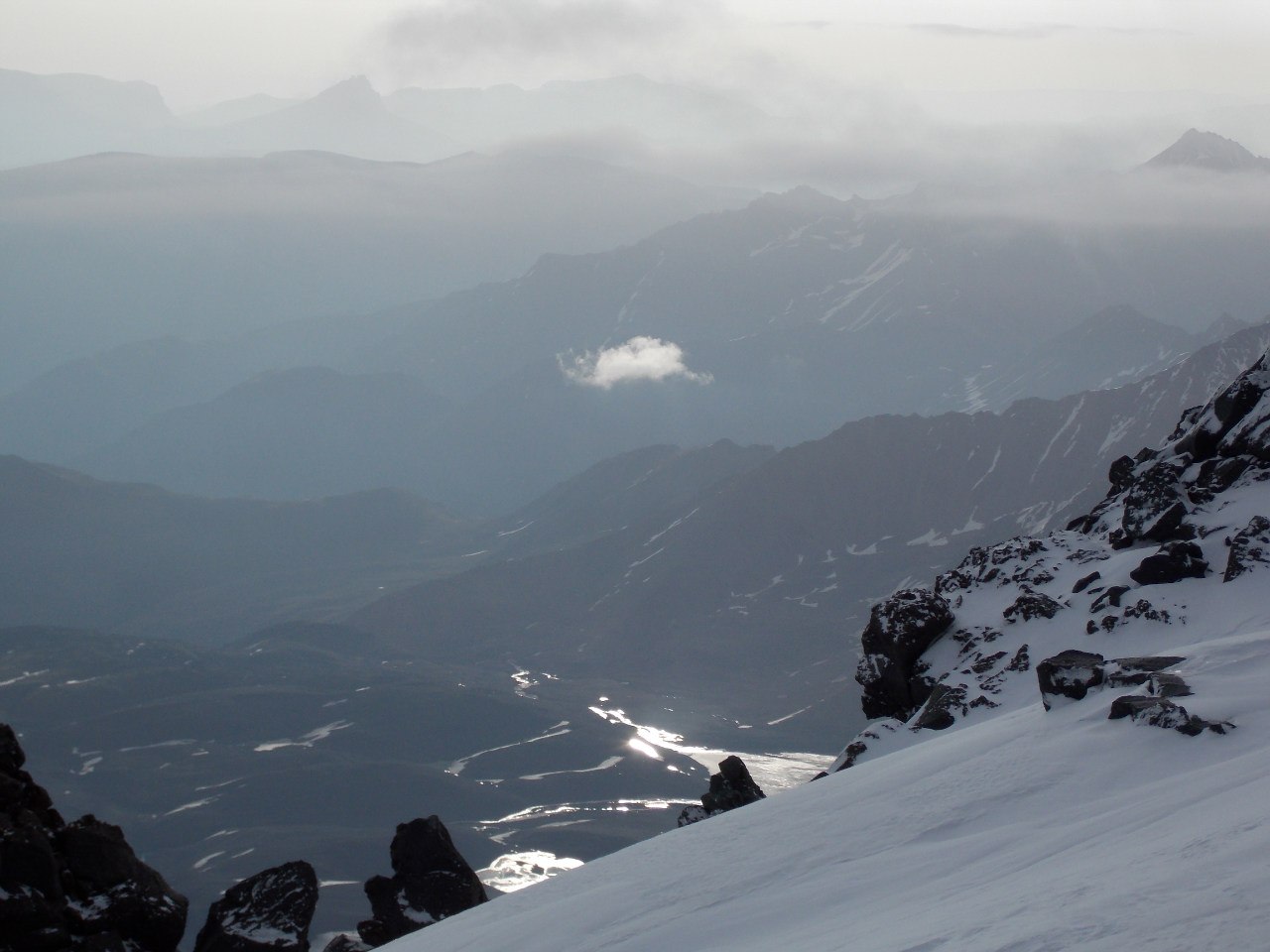
However, something brought me forward, starting from the very beginning.
For non-climbers I explain: before climbing to a height, in order not to grab a "mountain" disease, you must first acclimatize. Acclimatization can be “soft” - within 2 weeks you gradually accustom your body to height, and “hard” - which we had, that is, less than a week. And then immediately began the ascent to the top!
On the first day there was no snow and cold, but there was a lot of everything else: strength, excitement, weight in the backpack (everyone felt how much he took on the road!), Kilometers and fatigue.

For 7 hours it was necessary to climb from 2000 m to 3700 m, breaking the pass Balk-Bashi. On bending legs, with a buzzing head, barring nausea and other symptoms of the “miners”, through the impenetrable fog, wind and hail, we did reach!

Camped at an altitude of 3500 m and fell to sleep. But it was not there! It turns out that insomnia is also a symptom of a "mountain" disease! In general, nobody could fall asleep that night.
The second day was easier. The stocks of food in the backpacks were already a little eaten up, and on that day they did not have to go up, but to go down - from 3,500 m to 2,500 m to the valley of the Malka river. Symptoms of the "mountain" disease were not observed, the sun was shining brightly, the mood was very different. In general, it seemed that life was getting better.
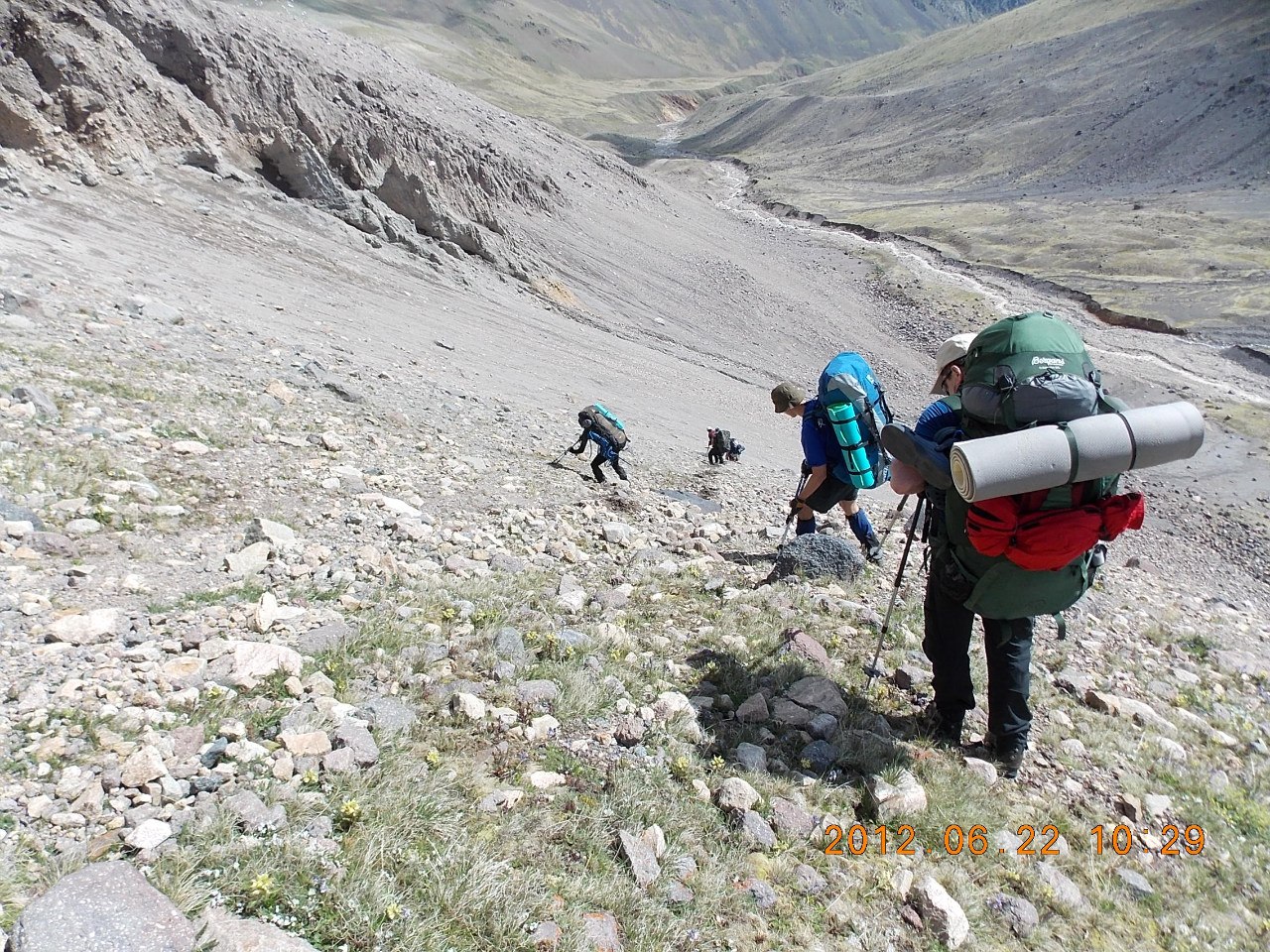
On the way we came across a slope at an angle of 45 - 50 °, all covered with pebbles, which crumbled under our feet and dragged down with us no worse than quicksand. Trekking sticks were saved - by leaning on them, it was possible to somehow pass this unpleasant part. So, resting on sticks, we mastered the "traverse descent". By the way, the same technique is used on the glacier, but instead of sticks, the handle of the ice ax is used.
Half a day later we reached the plateau "Aerodrome" , ideally even and flat "bottom of the bowl" of enormous size, surrounded on all sides by walls and mountains.

Beauty! In every sense: and that the spectacle is fascinating, and that a place for the tent does not need to look;)
About this place goes many legends and tales. For example, the fact that during the Second World War German planes aboard were landed here which were either German scientists from the Ahnenerbe organization or Tibetan lamas, who were buried here for predicting Hitler’s defeat. Or that until the 60s. of the last century, the plateau was closed for visits by direct orders from the NKVD first, and then the KGB, because it was planned to build an airport for the Soviet troops. In any case, the airport was never built here.
It is a pity, it would be both convenient and great - such a nature, such views ... I did not think that there would be such an abundance of flowers in the mountains.
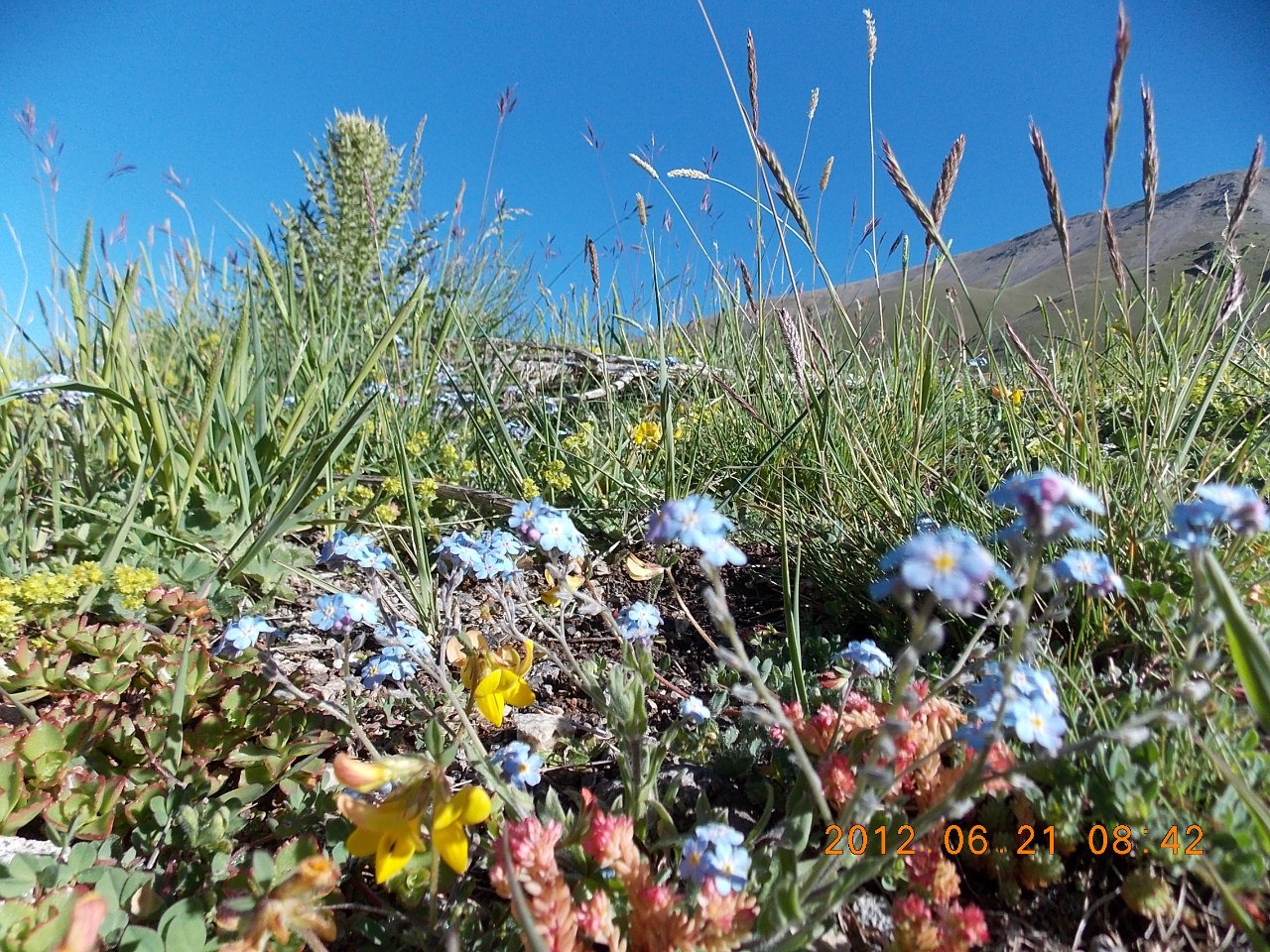
In addition, for the first time since the beginning of our adventure, a beautiful view of both peaks of Mount Elbrus opened.
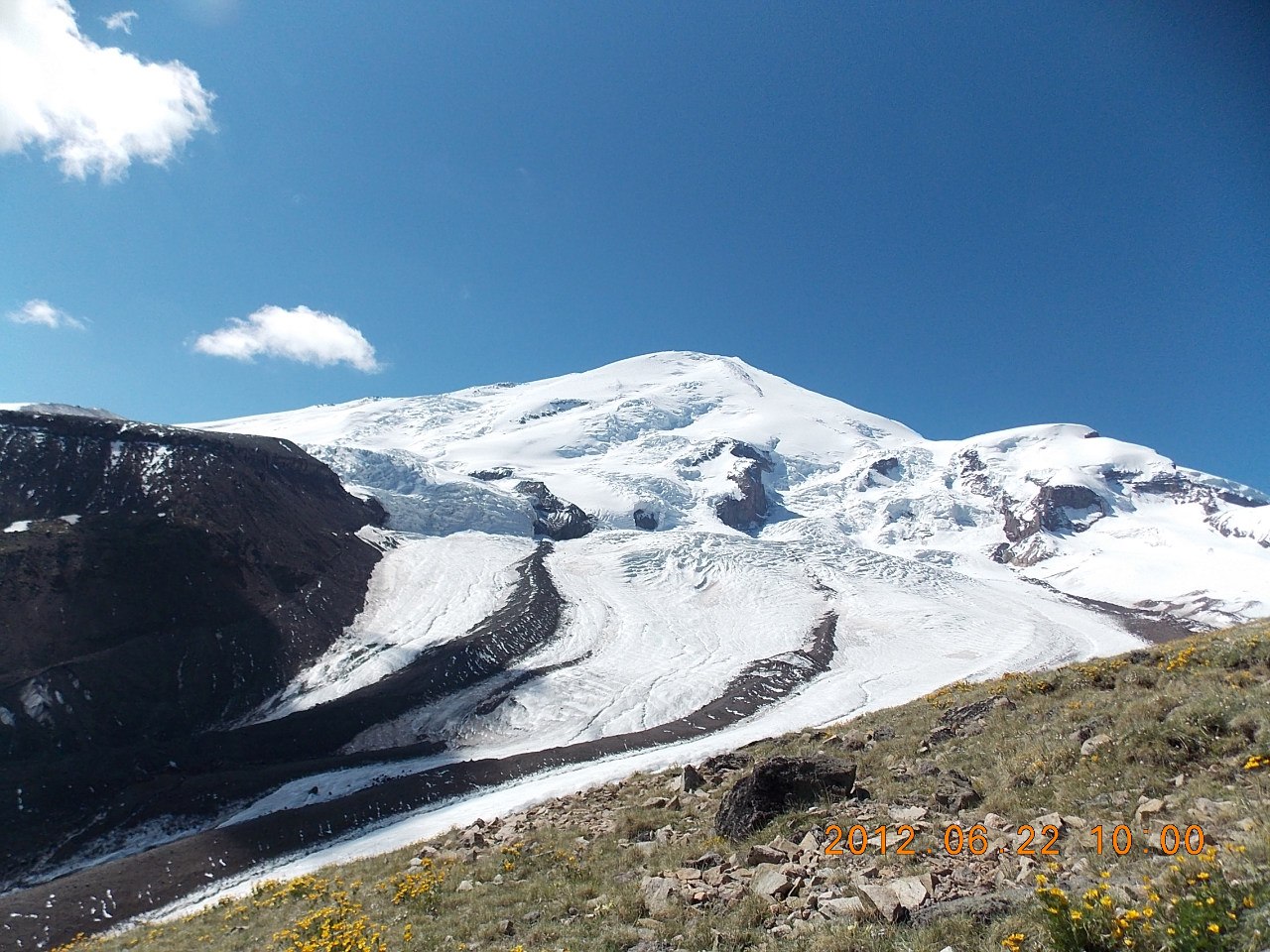
And the next day we "took off"! "Take-off" is a sharp transition from the plateau to the ascending serpentine path.
For the third day we had to walk to the Northern shelter, that is, to rise from 2500 m to 3700 m. The climb was much easier than on the first day, for two reasons at once: acclimatization did its job, plus we left everything unnecessary at the Aerodrome to grab on the way back.
The higher they rose, the gloom the weather became. When we reached our destination, the Northern Shelter, a squally wind rushed towards us, generously offering us rain and hail.
The Northern Shelter consisted of the base of the Ministry of Emergency Situations (mostly empty), Oleinikov's hut and several stationary houses. Such a small base camp, from which groups of climbers begin to storm the peaks of Elbrus.
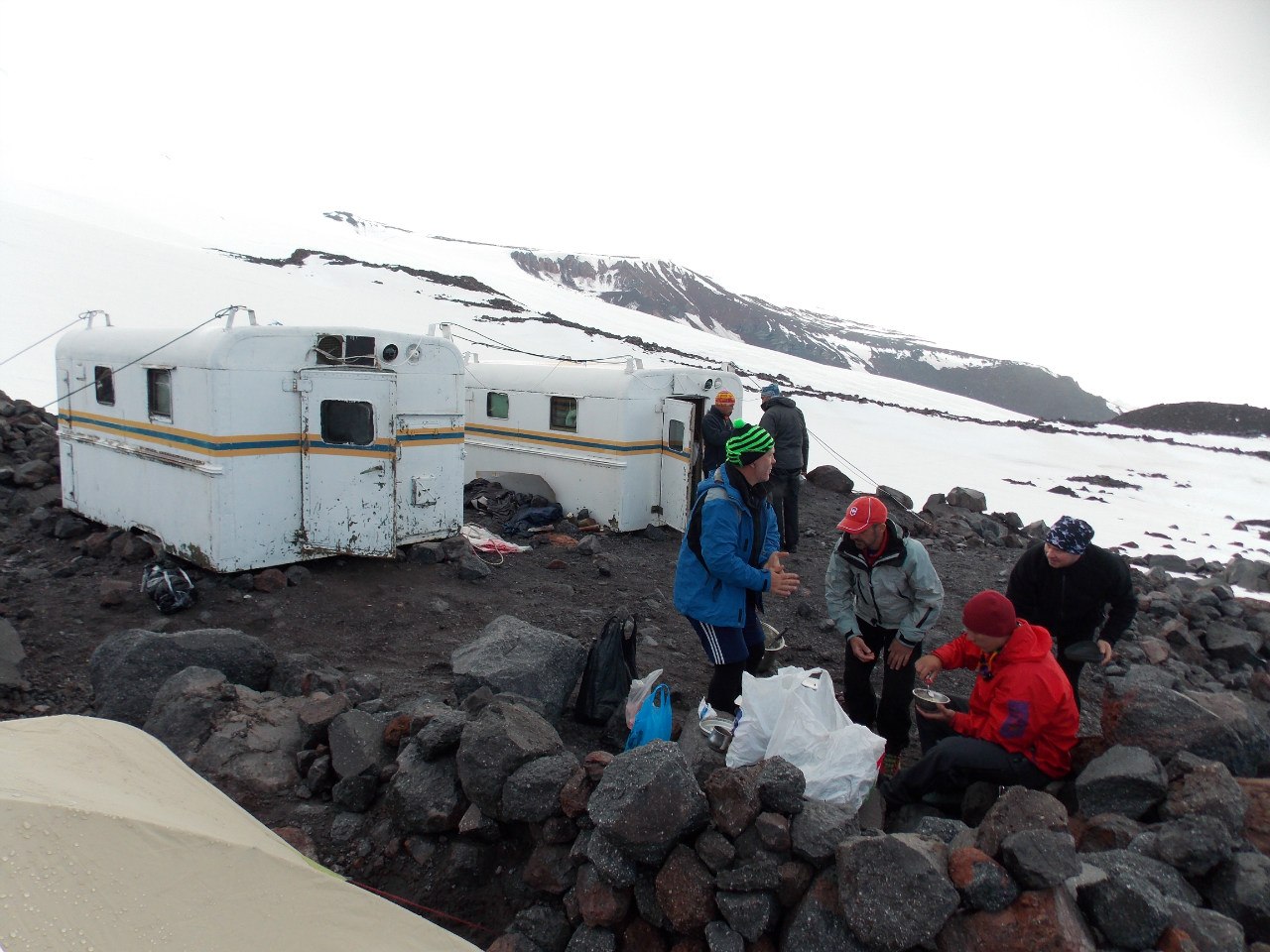
On the fourth day we made an acclimatization climb to the Lenz rocks (4500 m). For the first time tried climbing equipment (cats, a system with a carbine, ice axes, harness).

Hello, blinding snow and treacherous, hidden from the eyes of cracks! Powdered with snow, they can reach a depth of 150 m. Did you know that people die in the cracks of Elbrus every year?
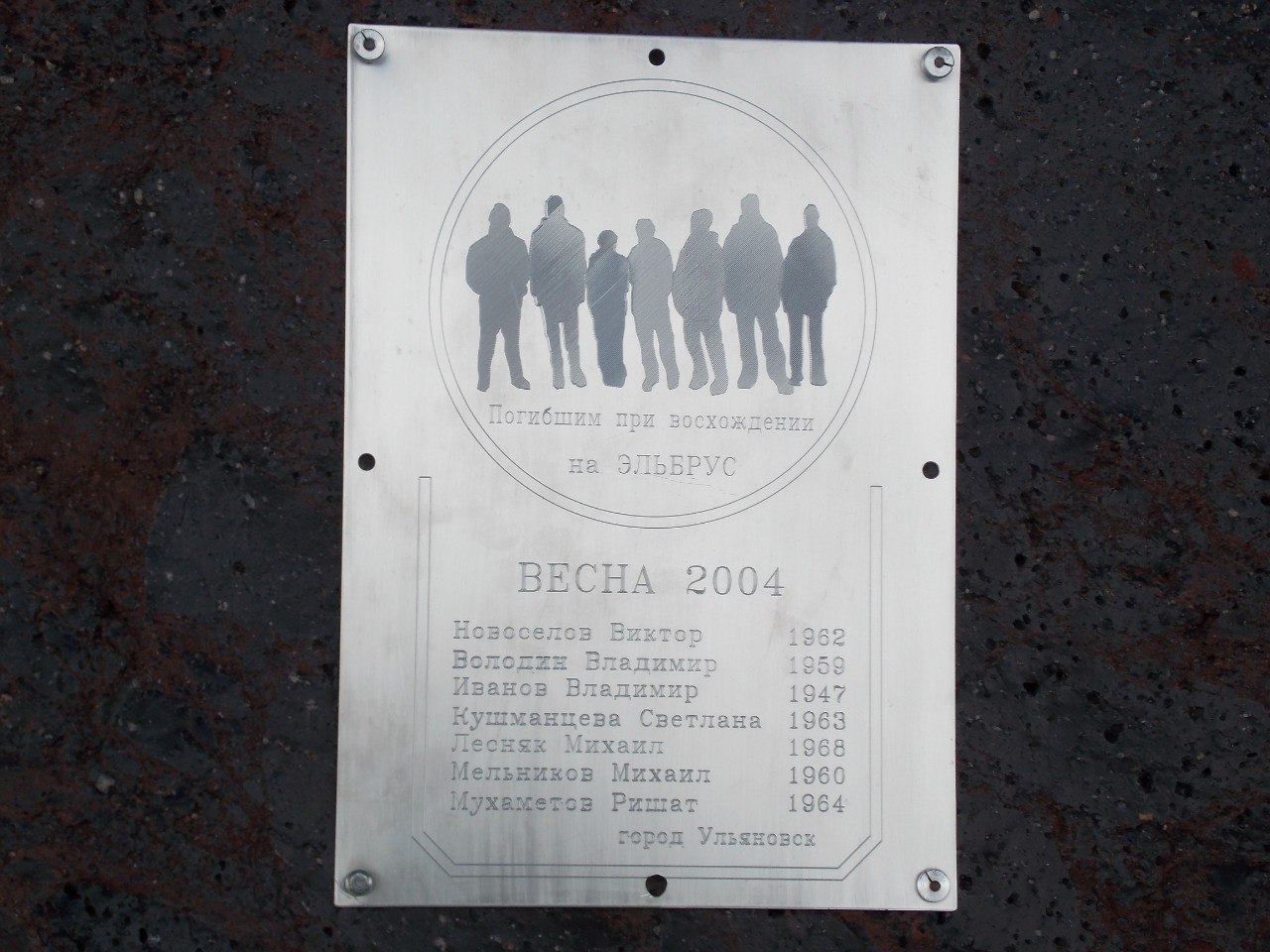
In 2 hours we reached the lower cliffs of Lenz. There, the instructors gave us an introductory course in mountaineering training, having taught several basic techniques how to behave on a steep climb, on a steep descent and in case of a breakdown.
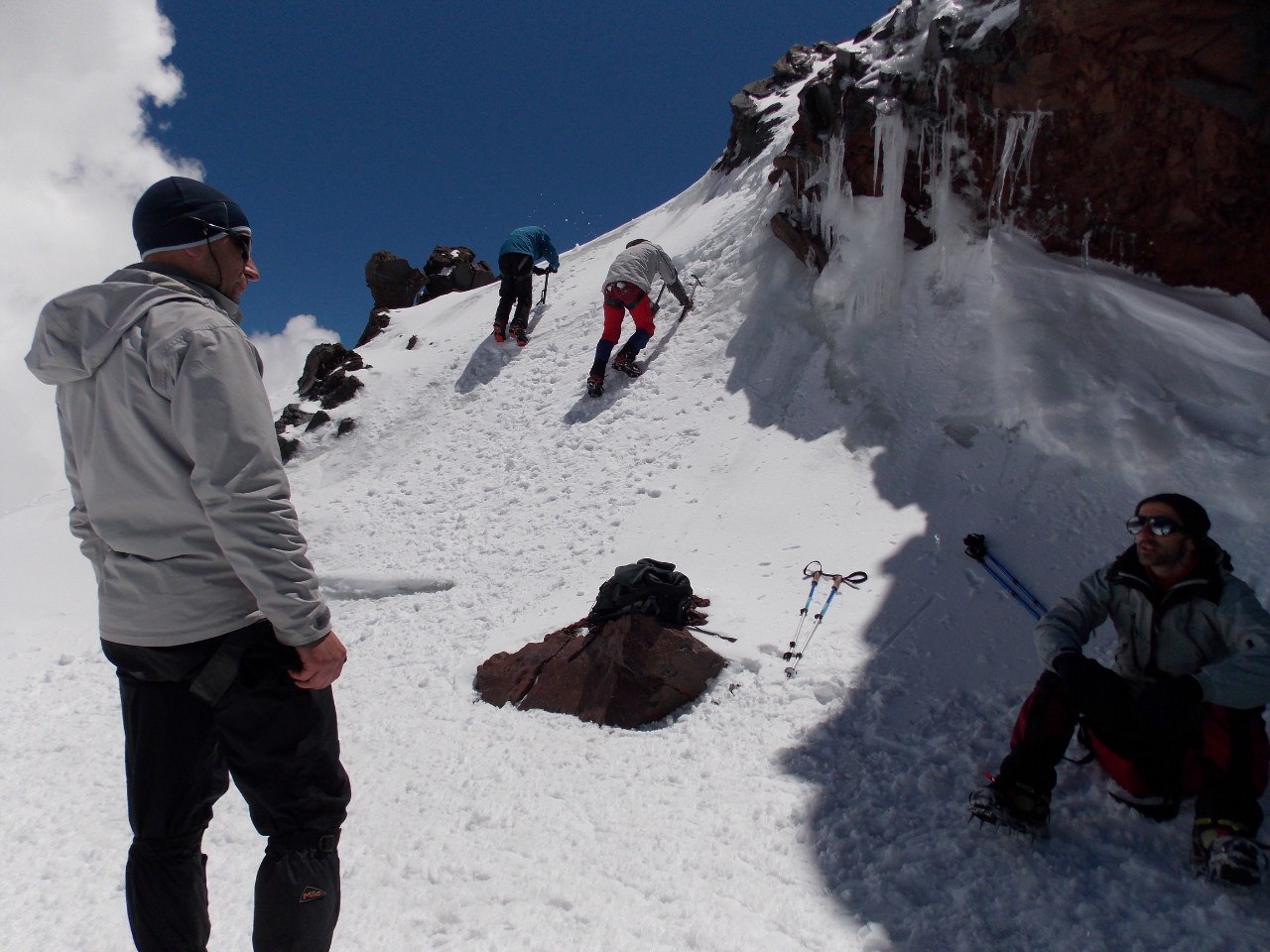
Everyone immediately felt like real climbers;)
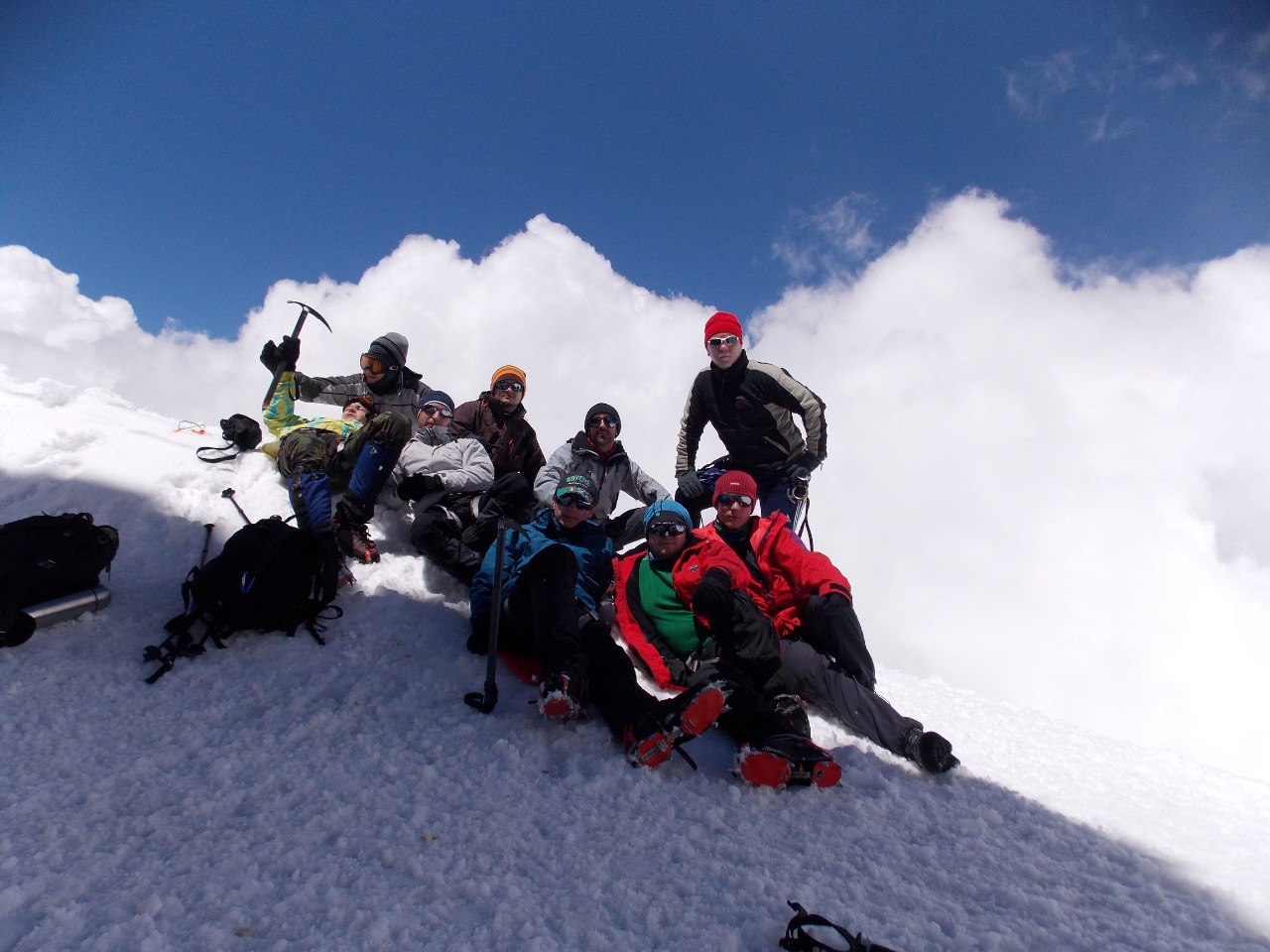
We spent several more hours on the lower cliffs of Lenz, following the law of acclimatization: “Get higher, sleep lower!”. And then we went down to the camp to prepare for the upcoming climb to the top.

The fifth day was marked by the rest before the main "event". During the holidays, the choir sang Russian and Ukrainian songs, as in our team six out of nine people were from Ukraine. Such fraternization fraternal peoples;)

And here he is the sixth day ! Rather, the night between the 5th and 6th day. Out of the base camp to storm the summit at 1 am.
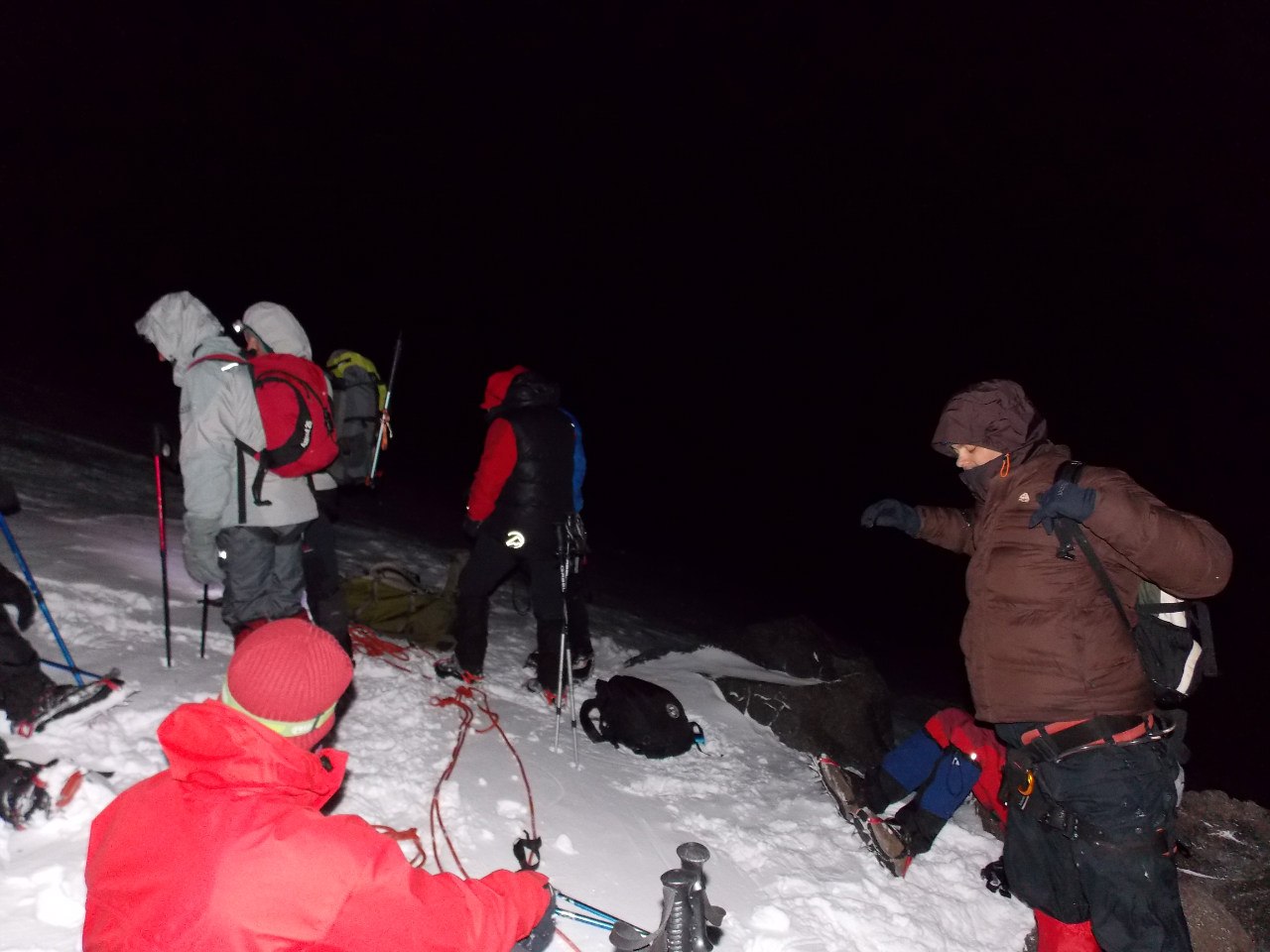
The ascent itself lasted about 10 hours, the descent back to the camp about 4 hours.
Dawn caught us at 4.30 at the rocks of Lenz. It was stunningly beautiful; not every artist can have such paints on the canvas.
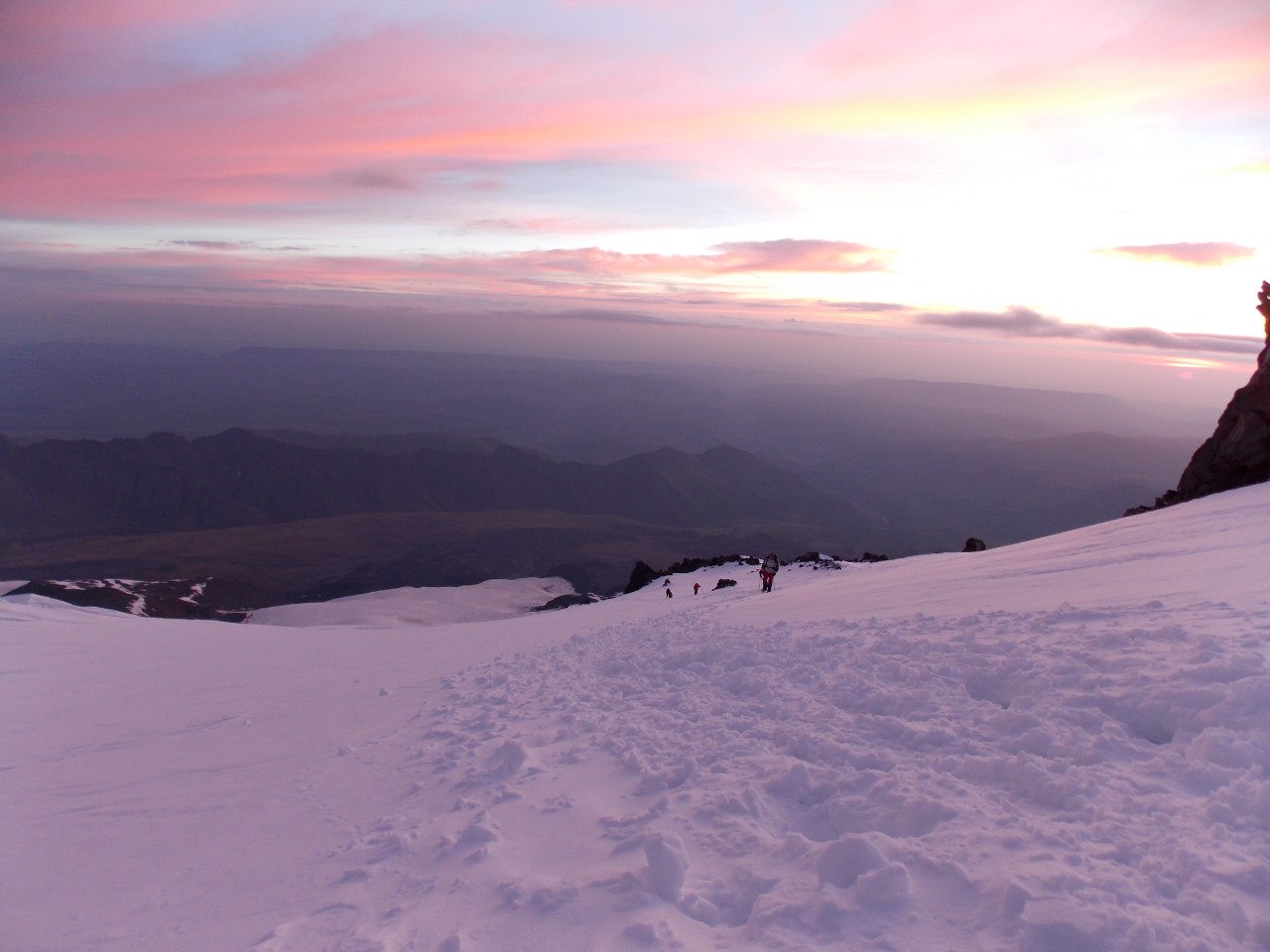
I would be incredibly happy to realize that I can see all this if ... If my thoughts did not freeze on the fly! Even in July, the thermometer on Elbrus never rises above zero. A similar temperature during this period is observed only in Antarctica and Greenland. Between one o'clock in the morning and five o'clock in the morning on Elbrus is really very cold!
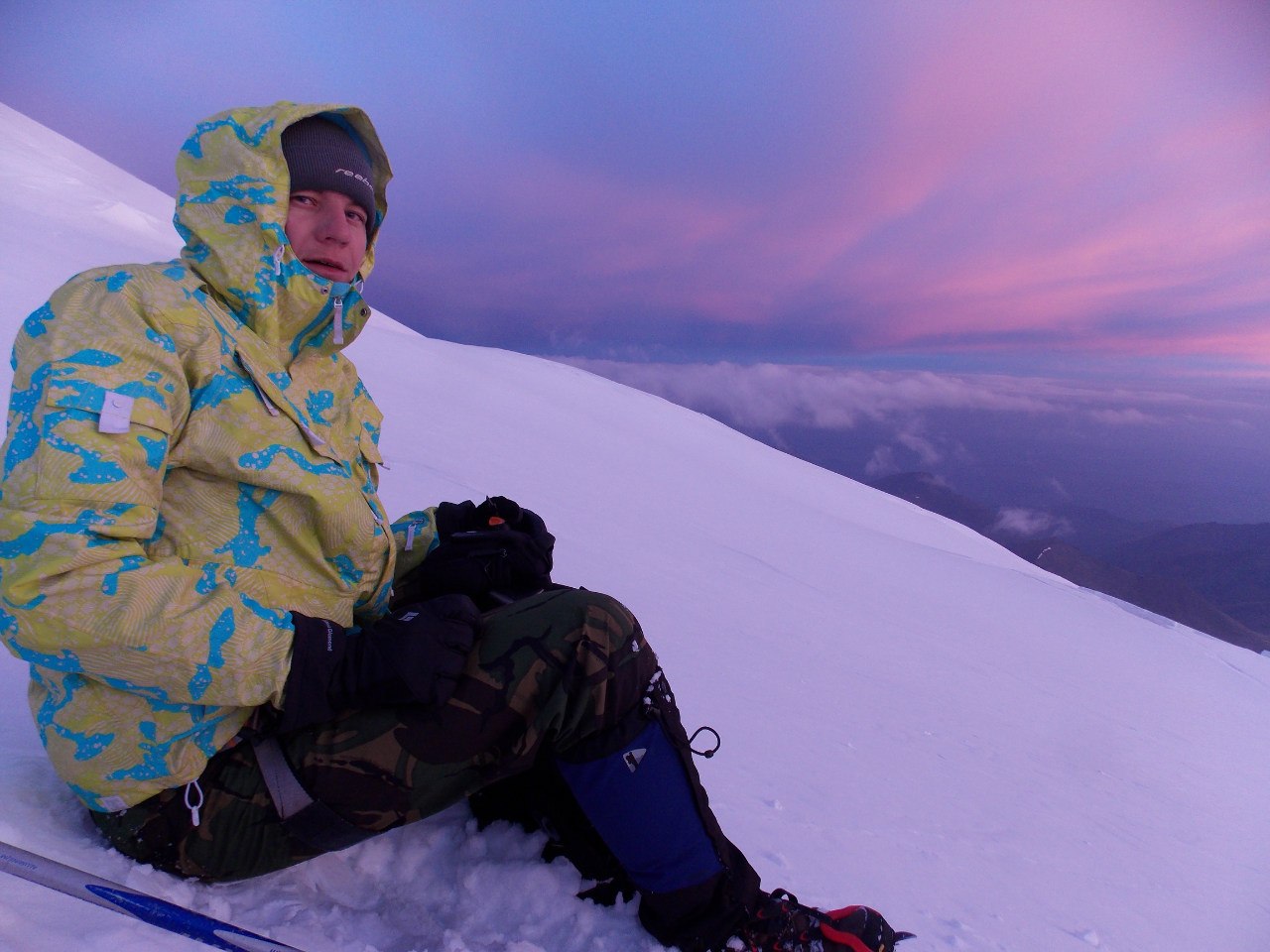
The guys around are starting to complain about the numbness of the fingers and toes. Someone shares with a friend mittens. Someone recollects and immediately applies, as it turned out, the best way to warm up the toes - swing legs.
After 7 hours of continuous ascent, we are already at an altitude of about 5,100 - 5,200 m. The forces are running out, and ahead is the steepest climb in front of the top. The closer to it, the more ice becomes around and less snow. The more carefully you have to look where you step and, especially, sit down to rest - you can start to slide down, which, frankly, in the mountains is not as pleasant as from an ice slide during winter festivities.
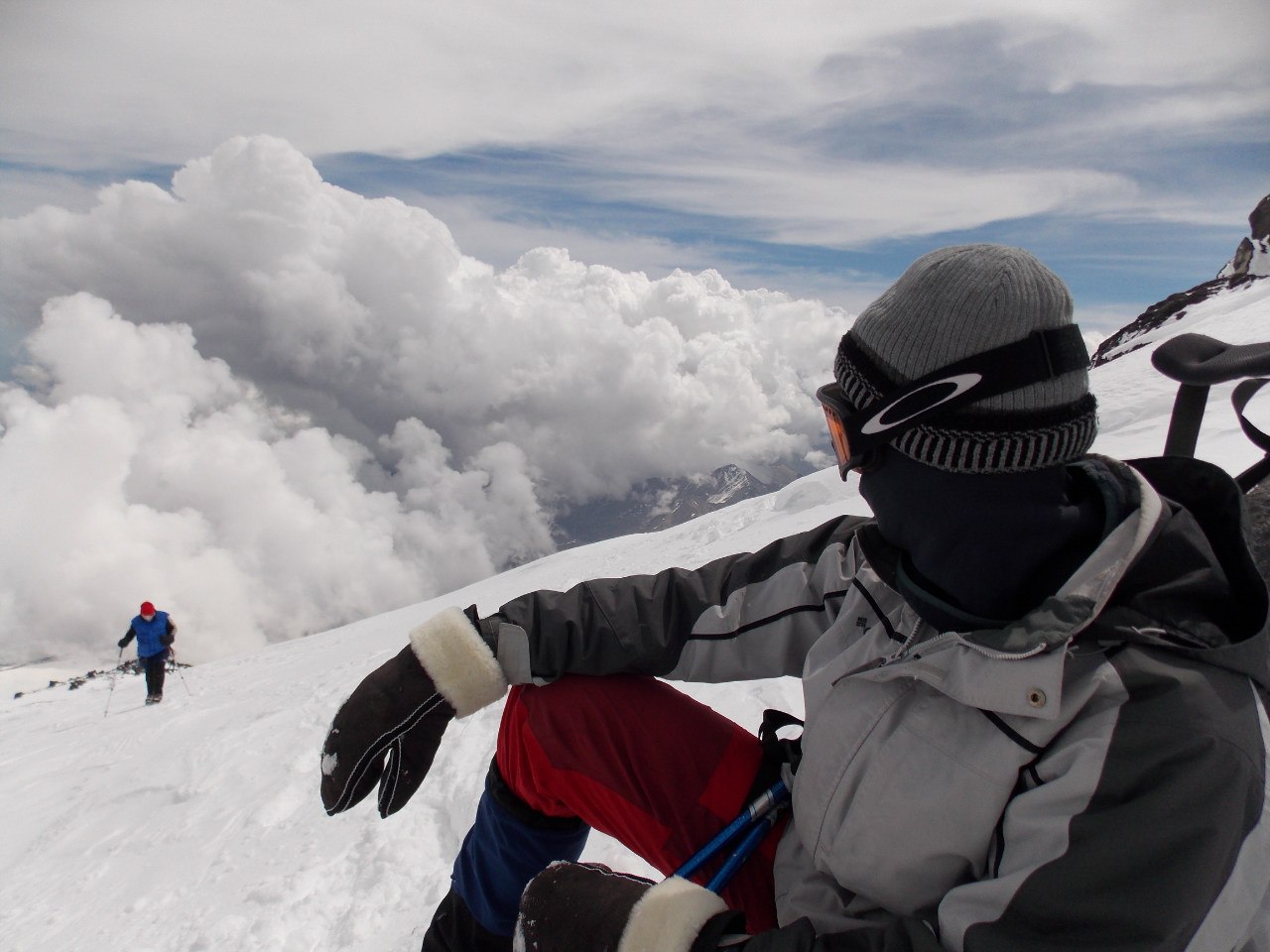
And yet we did it! We overcame the last climb, reached the plateau. The height is about 5550 m. To the summit it turns out to be about half an hour more.

The raging wind stretches these half an hour for at least an hour, trying either to tear you away from the surface of the rock, or together with the sun, scorching through the thin air, to polish your skin to the state of dazzling ice in the rays.
Iiii ... Top!

This is an incomparable feeling when you stand on the top ... So, it is incomparable with the feeling when you stand on the REAL TOP!
And, of course, I could not deny myself the pleasure of taking pictures with the REG.RU flag on top!

And what did it cost me ... To stand on the top blown by the winds, feeling all the symptoms of the “miners”, put the REG.RU flag on the trekking stick as a flagpole and photograph myself!
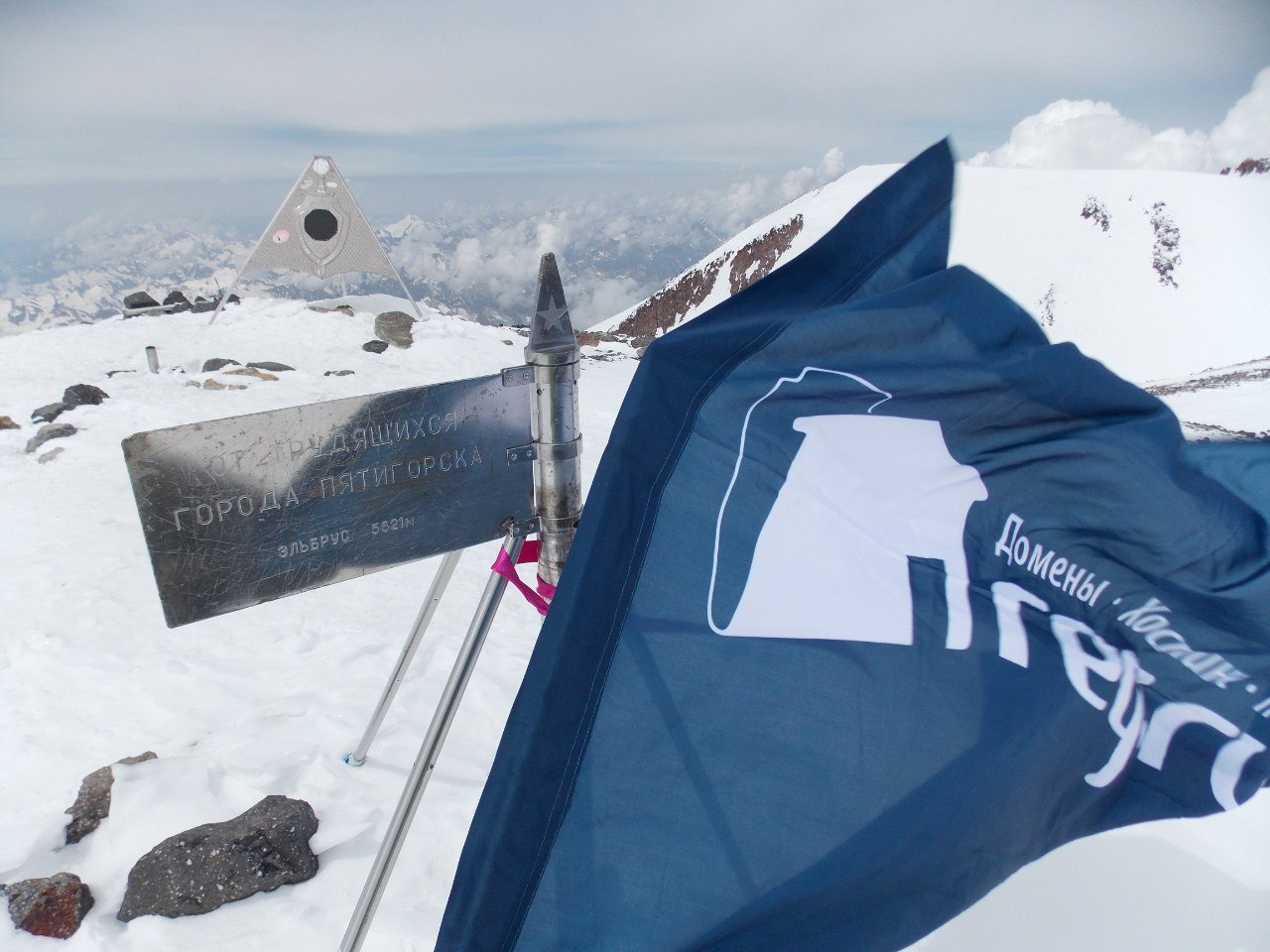
Because my friend became very, very ill at the height of lack of oxygen and he could only “click” me. But as soon as we descended to 1000 m, he immediately felt better.
The descent took place in conditions of almost zero visibility on noticeably grown snowdrifts. Apparently, while we conquered the summit, there was a steady snowfall.
Upon returning to the camp, we barely had enough strength to throw clothes to dry on the next stones and crawl around the tents. And when we woke up, instead of clothes and stones, we were surrounded only by drifts, drifts, drifts. The weather in the mountains, that feminine mood: changes suddenly and for no apparent reason!
When the next day ( the seventh day , comes out), we descended to 2500 m, I was so happy to see the low, rare, but green grass after the realm of endless stone, snow and ice. On the way down, we came into contact with the diverse wonders of Gila-Su nature - stone mushrooms, which are a place of power for many shamans of the past and, probably, of the present, tried amazingly tasty water from a narzan spring from under the rock, plunged into a warm bath with mineral water natural origin.
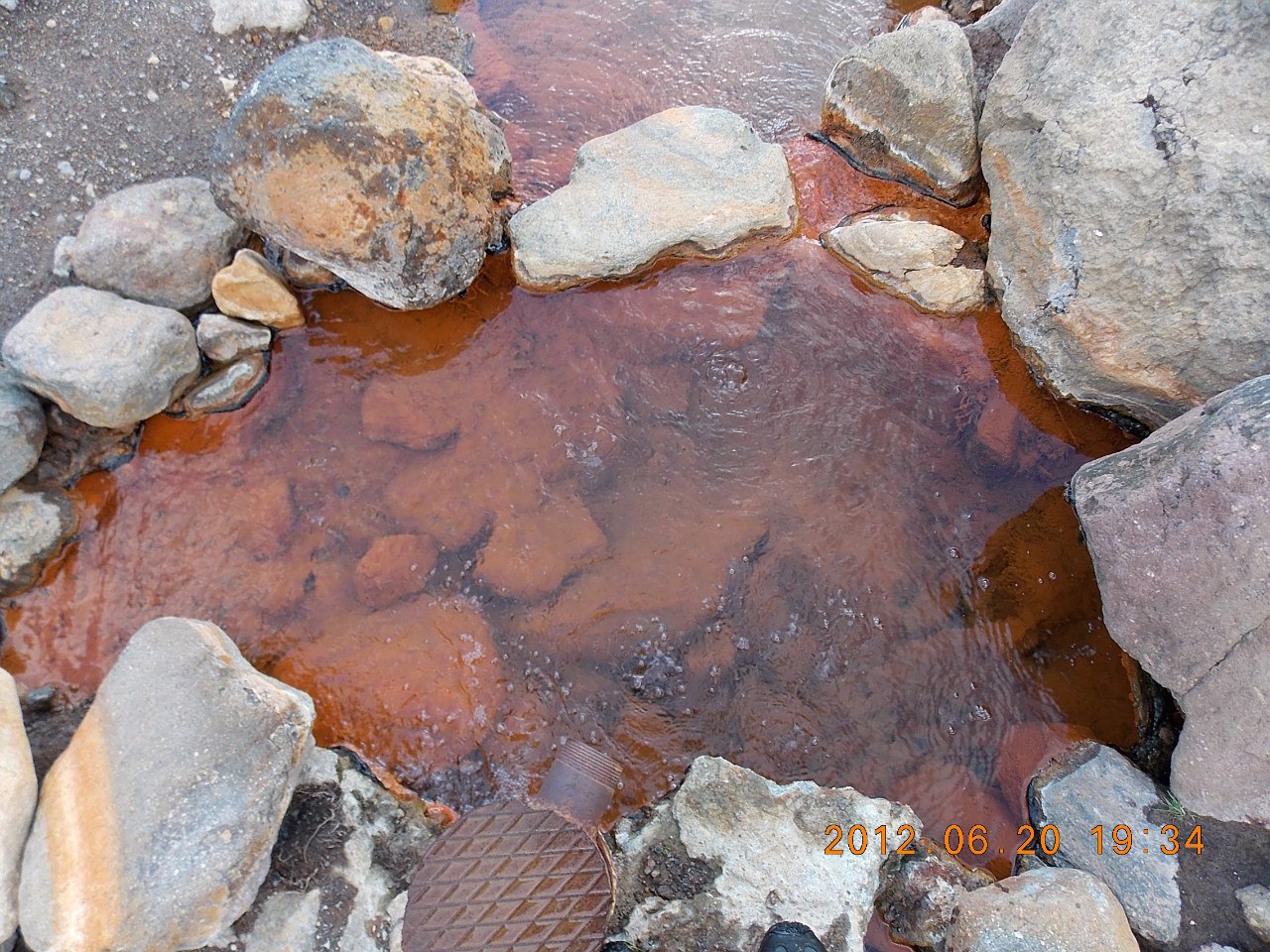
After this hike, I fell in love with the mountains forever. It's worth it. Really worth it. So, I hope, “not far off” the assault on other peaks! ;)
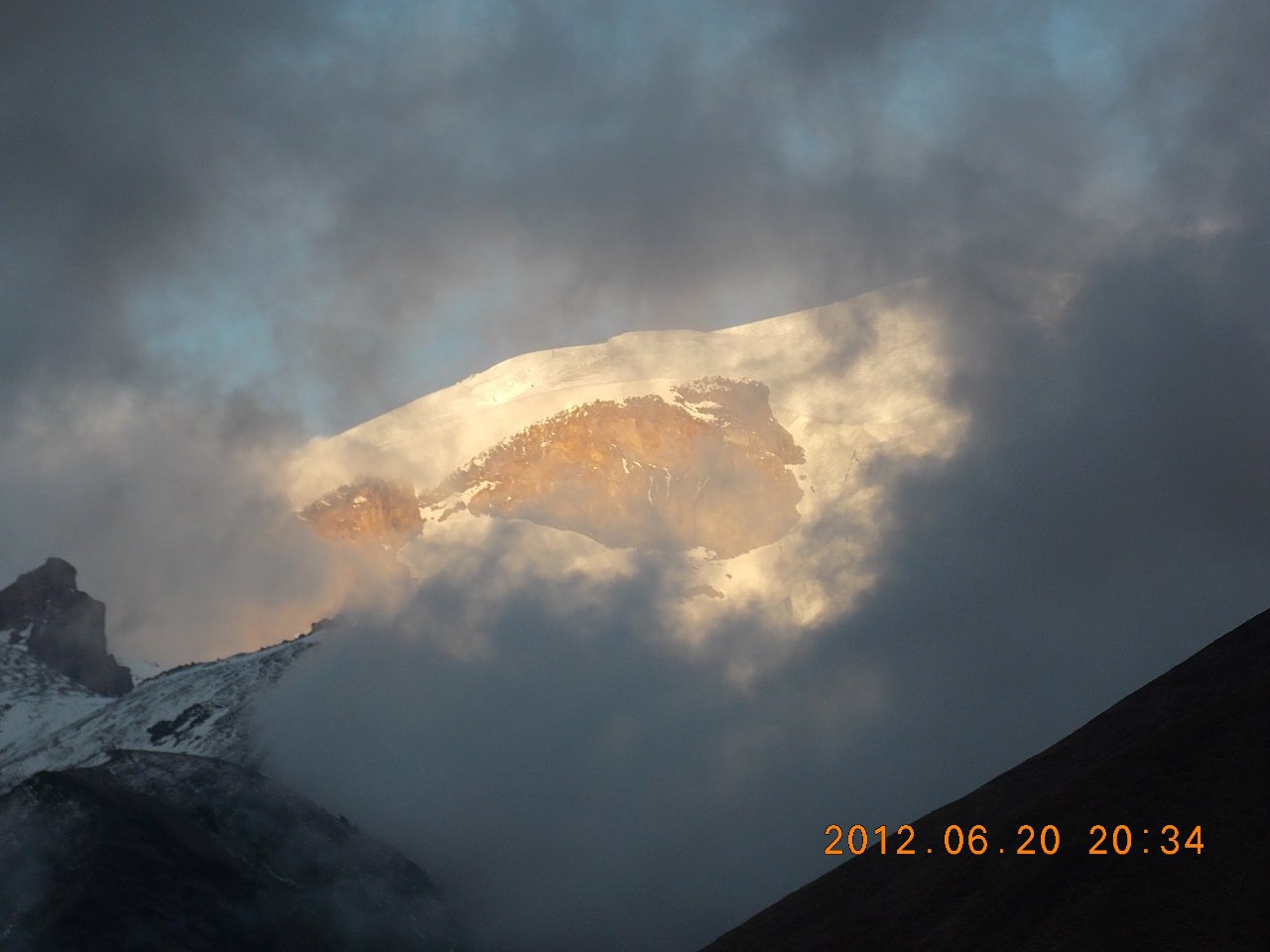
Recently, I don’t want to bore you with statistics or post technical instructions — outside the window of heat and stuffiness, body and soul crave for something fresh and different from the routine of everyday work. Fresh as the mountain air. Unusual, as the banner REG.RU, waving at a height of 5621 m above the ground.
So I decided to tell you how just a couple of weeks ago I decided to go to the mountains for the first time, and not somewhere, but at the highest peak of Europe - Elbrus.

')
We must immediately say that physically it was not easy. “Hard” acclimatization, “mountain” illness (headache, insomnia, weakness, shortness of breath after minimal physical activity), heavy backpacks (they approached Elbrus for three days from the North, the most difficult part). At the same time, I have never had such inner peace, I have never been so relaxed from the bustle of the city, as in these majestic, monumental mountains of amazing beauty.


However, something brought me forward, starting from the very beginning.
For non-climbers I explain: before climbing to a height, in order not to grab a "mountain" disease, you must first acclimatize. Acclimatization can be “soft” - within 2 weeks you gradually accustom your body to height, and “hard” - which we had, that is, less than a week. And then immediately began the ascent to the top!
On the first day there was no snow and cold, but there was a lot of everything else: strength, excitement, weight in the backpack (everyone felt how much he took on the road!), Kilometers and fatigue.

For 7 hours it was necessary to climb from 2000 m to 3700 m, breaking the pass Balk-Bashi. On bending legs, with a buzzing head, barring nausea and other symptoms of the “miners”, through the impenetrable fog, wind and hail, we did reach!

Camped at an altitude of 3500 m and fell to sleep. But it was not there! It turns out that insomnia is also a symptom of a "mountain" disease! In general, nobody could fall asleep that night.
The second day was easier. The stocks of food in the backpacks were already a little eaten up, and on that day they did not have to go up, but to go down - from 3,500 m to 2,500 m to the valley of the Malka river. Symptoms of the "mountain" disease were not observed, the sun was shining brightly, the mood was very different. In general, it seemed that life was getting better.

On the way we came across a slope at an angle of 45 - 50 °, all covered with pebbles, which crumbled under our feet and dragged down with us no worse than quicksand. Trekking sticks were saved - by leaning on them, it was possible to somehow pass this unpleasant part. So, resting on sticks, we mastered the "traverse descent". By the way, the same technique is used on the glacier, but instead of sticks, the handle of the ice ax is used.
Half a day later we reached the plateau "Aerodrome" , ideally even and flat "bottom of the bowl" of enormous size, surrounded on all sides by walls and mountains.

Beauty! In every sense: and that the spectacle is fascinating, and that a place for the tent does not need to look;)
About this place goes many legends and tales. For example, the fact that during the Second World War German planes aboard were landed here which were either German scientists from the Ahnenerbe organization or Tibetan lamas, who were buried here for predicting Hitler’s defeat. Or that until the 60s. of the last century, the plateau was closed for visits by direct orders from the NKVD first, and then the KGB, because it was planned to build an airport for the Soviet troops. In any case, the airport was never built here.
It is a pity, it would be both convenient and great - such a nature, such views ... I did not think that there would be such an abundance of flowers in the mountains.

In addition, for the first time since the beginning of our adventure, a beautiful view of both peaks of Mount Elbrus opened.

And the next day we "took off"! "Take-off" is a sharp transition from the plateau to the ascending serpentine path.
For the third day we had to walk to the Northern shelter, that is, to rise from 2500 m to 3700 m. The climb was much easier than on the first day, for two reasons at once: acclimatization did its job, plus we left everything unnecessary at the Aerodrome to grab on the way back.
The higher they rose, the gloom the weather became. When we reached our destination, the Northern Shelter, a squally wind rushed towards us, generously offering us rain and hail.
The Northern Shelter consisted of the base of the Ministry of Emergency Situations (mostly empty), Oleinikov's hut and several stationary houses. Such a small base camp, from which groups of climbers begin to storm the peaks of Elbrus.

On the fourth day we made an acclimatization climb to the Lenz rocks (4500 m). For the first time tried climbing equipment (cats, a system with a carbine, ice axes, harness).

Hello, blinding snow and treacherous, hidden from the eyes of cracks! Powdered with snow, they can reach a depth of 150 m. Did you know that people die in the cracks of Elbrus every year?

In 2 hours we reached the lower cliffs of Lenz. There, the instructors gave us an introductory course in mountaineering training, having taught several basic techniques how to behave on a steep climb, on a steep descent and in case of a breakdown.

Everyone immediately felt like real climbers;)

We spent several more hours on the lower cliffs of Lenz, following the law of acclimatization: “Get higher, sleep lower!”. And then we went down to the camp to prepare for the upcoming climb to the top.

The fifth day was marked by the rest before the main "event". During the holidays, the choir sang Russian and Ukrainian songs, as in our team six out of nine people were from Ukraine. Such fraternization fraternal peoples;)

And here he is the sixth day ! Rather, the night between the 5th and 6th day. Out of the base camp to storm the summit at 1 am.

The ascent itself lasted about 10 hours, the descent back to the camp about 4 hours.
Dawn caught us at 4.30 at the rocks of Lenz. It was stunningly beautiful; not every artist can have such paints on the canvas.

I would be incredibly happy to realize that I can see all this if ... If my thoughts did not freeze on the fly! Even in July, the thermometer on Elbrus never rises above zero. A similar temperature during this period is observed only in Antarctica and Greenland. Between one o'clock in the morning and five o'clock in the morning on Elbrus is really very cold!

The guys around are starting to complain about the numbness of the fingers and toes. Someone shares with a friend mittens. Someone recollects and immediately applies, as it turned out, the best way to warm up the toes - swing legs.
After 7 hours of continuous ascent, we are already at an altitude of about 5,100 - 5,200 m. The forces are running out, and ahead is the steepest climb in front of the top. The closer to it, the more ice becomes around and less snow. The more carefully you have to look where you step and, especially, sit down to rest - you can start to slide down, which, frankly, in the mountains is not as pleasant as from an ice slide during winter festivities.

And yet we did it! We overcame the last climb, reached the plateau. The height is about 5550 m. To the summit it turns out to be about half an hour more.

The raging wind stretches these half an hour for at least an hour, trying either to tear you away from the surface of the rock, or together with the sun, scorching through the thin air, to polish your skin to the state of dazzling ice in the rays.
Iiii ... Top!

This is an incomparable feeling when you stand on the top ... So, it is incomparable with the feeling when you stand on the REAL TOP!
And, of course, I could not deny myself the pleasure of taking pictures with the REG.RU flag on top!

And what did it cost me ... To stand on the top blown by the winds, feeling all the symptoms of the “miners”, put the REG.RU flag on the trekking stick as a flagpole and photograph myself!

Because my friend became very, very ill at the height of lack of oxygen and he could only “click” me. But as soon as we descended to 1000 m, he immediately felt better.
The descent took place in conditions of almost zero visibility on noticeably grown snowdrifts. Apparently, while we conquered the summit, there was a steady snowfall.
Upon returning to the camp, we barely had enough strength to throw clothes to dry on the next stones and crawl around the tents. And when we woke up, instead of clothes and stones, we were surrounded only by drifts, drifts, drifts. The weather in the mountains, that feminine mood: changes suddenly and for no apparent reason!
When the next day ( the seventh day , comes out), we descended to 2500 m, I was so happy to see the low, rare, but green grass after the realm of endless stone, snow and ice. On the way down, we came into contact with the diverse wonders of Gila-Su nature - stone mushrooms, which are a place of power for many shamans of the past and, probably, of the present, tried amazingly tasty water from a narzan spring from under the rock, plunged into a warm bath with mineral water natural origin.

After this hike, I fell in love with the mountains forever. It's worth it. Really worth it. So, I hope, “not far off” the assault on other peaks! ;)

Source: https://habr.com/ru/post/147269/
All Articles